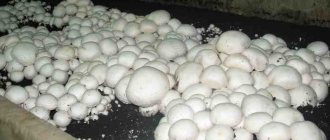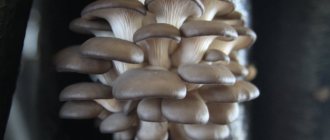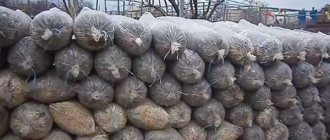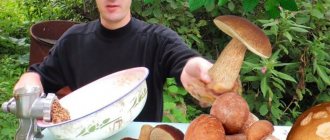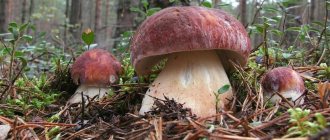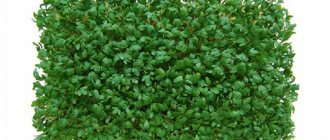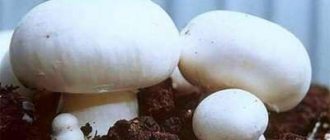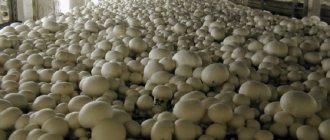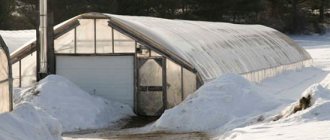Growing mushrooms in a greenhouse is a promising branch of agriculture. This culture can always be found on the shelves of supermarkets or markets. But it’s much more pleasant to grow it yourself on your own plot. This is not to say that the growing process is quite complicated. You just need a little patience and time. The result will not be long in coming; all the effort expended will be compensated by a good harvest.
Growing mushrooms in a greenhouse is a profitable business
Features of growing mushrooms in a greenhouse
When growing mushrooms in a greenhouse, you should create conditions that are as close to natural as possible.
Therefore, you need to do the following:
- Set up a greenhouse.
- Select varieties.
- Prepare the soil.
- Adjust temperature.
- Determine the optimal humidity level.
- Carry out proper care.
Benefits of growing mushrooms in a greenhouse
- Collection all year round.
- Unpretentiousness of the plant.
- Frequent harvesting.
- Variety of varieties.
- Sales for sale.
- Possibility of preparing various dishes.
- Useful composition.
Absolutely anyone can grow mushrooms. This type of activity does not require special skills, knowledge, or special fertilizers and equipment. An ordinary garden greenhouse is suitable for growing them.
Mushroom varieties for growing in a greenhouse
The following varieties are suitable for cultivation:
- Champignon.
- Oyster mushrooms.
- White mushrooms.
These are the most common and accessible types of mushrooms among consumers, distinguished by their extraordinary aroma and taste. Many people start their own business using these varieties, growing mushrooms for sale.
Arrangement of a greenhouse for growing mushrooms
As a rule, each individual variety of mushroom requires an individual greenhouse. But for growing a small amount of mushrooms, an ordinary universal one is suitable. Then you can grow several species in it at once.
The greenhouse must have the following elements:
- Heating. A water system will be optimal. This will maintain a favorable level of air humidity.
- Impermeable material is important for maintaining the special climate in the greenhouse, which is important for year-round mushroom cultivation.
- Ventilation. Mushrooms need fresh air. Otherwise, rot may form in the mycelium.
- Water. Without this substance, not a single mycelium can exist. Since greenhouses are usually large and elongated, it would be good to install an irrigation system.
- Protection from light. Mushrooms do not need ultraviolet light to grow and develop. On the contrary, it is recommended to darken the roof of the greenhouse by placing another layer of matte material on top.
- Shelving and containers. Inside the greenhouse it is necessary to install racks and shelves to accommodate the varieties being grown.
Microclimate in the room for champignons
Amateur cultivation of champignons is possible in open ground. However, this is only possible in areas with a warm and temperate climate, where the frost-free period lasts at least six months.
First of all, you need to build light shelters. With their help, optimal air and temperature conditions are created, and the compost does not overheat. Shelters can be built in the form of a greenhouse (arcs with a stretched film over the ground) or arranged near the wall of a stone building. Recommendations for arranging greenhouses and greenhouses for growing champignons are shown in Figure 7.
Figure 7. Options for greenhouses for growing champignons: a - two-tier greenhouse (1 - wooden wall, 2 - bed, 3 - clay floor, 4 - wooden stand with crossbars, 5 - gable roof, 6 - layer of thermal insulation, 7 - ventilation hole ), b - wall-mounted greenhouse (1 - compost, 2 - brick wall, 3 - concrete blind area, 4 - frame with film), c - compact greenhouse for amateur cultivation (1 - wooden wall, 2 - beds with mushrooms, 3 - earthen floor, 4 - stand, 5 - roof or greenhouse frame, 6 - layer of horse manure, 7 - vent)
You should also follow some recommendations:
- Compost cannot be laid on open ground. To do this, use thick polyethylene film or roofing felt;
- When installing a wall-mounted mushroom maker, it should be located on the north side of the building;
- To grow mushrooms, you can use basements, cellars or natural caves.
Pros and cons of growing mushrooms in a greenhouse
Many gardeners and gardeners grow mushrooms not only for sale, but also for their table. The benefits are as follows:
- Taste. This is perhaps the main feature of any variety.
- To grow mushrooms, no equipment other than a greenhouse is required.
- Under good conditions, mushrooms grow continuously.
There are practically no disadvantages, except perhaps the costs of running electricity and a watering system in the greenhouse.
Boletus
Boletus is a forest mushroom, belongs to the tubular type and grows in mixed forests.
Characteristic
The color of the cap depends on the growing conditions, most often it is orange or red. Reaches 30 cm and is located on a thick light stalk. The strong pulp has a specific aroma. The mushroom is pink when cut, but quickly turns black. The average yield is 5-15 mushrooms per 1 sq. m. If proper care is taken, the yield will last for 4-5 years.
Features of planting and care in a greenhouse
The most commonly used is grain mycelium. Grains infected with fungal spores act as a starting nutrient substrate. Plantings should be protected from drafts and high humidity should be maintained. To obtain maximum efficiency of mycelium, aspens or other forest trees should be located near the plantings.
The planting of beds is carried out from May to September. Wet compost is mixed with planting material and covered with polyethylene. Care consists of maintaining constant humidity of the air and substrate. Drying out leads to the death of the mycelium.
Features of cultivation of various species
In order to successfully grow mushrooms, you need to know what care will be optimal for each species.
Honey mushrooms
Growing honey mushrooms requires a large amount of moisture. Therefore, a necessary condition will be the installation of a watering system in the greenhouse.
- They need to be grown in special elongated containers.
- In order to purchase mycelium, you need to contact breeders of this variety of mushrooms.
Oyster mushrooms
Such mushrooms grow in large myceliums. Therefore, it is more convenient to place them on racks. The air humidity inside the room should reach 90 degrees, and the temperature should correspond to 15 degrees Celsius. Oyster mushrooms are unpretentious mushrooms, and under the right conditions they will grow and develop well.
Champignon
These mushrooms require a lot of light and additional lighting. It is important to arrange the greenhouse so that the mushrooms do not lack ultraviolet radiation.
This variety of mushrooms needs extended daylight hours, so additional lighting can be left until nine o’clock in the evening.
There is no need to ventilate the greenhouse; champignons love very humid, stuffy and damp air. Watering should be done 2-3 times a week.
Porcini
This elite variety of mushrooms requires attention and certain conditions for rapid growth and reproduction.
- The porcini mushroom is grown in soil, which should be moist, nutritious and rich in vitamins.
- It can be fertilized with manure. This variety feels great in darkened greenhouses.
Greenhouse organization
It is customary to grow mushrooms in cold weather - from October to April, so often for this purpose they use an ordinary greenhouse made of film, which has already been freed from vegetables. Meanwhile, in order to convert a conventional polycarbonate greenhouse for growing mushrooms, a number of changes will need to be made to the design. In the future, the converted greenhouse can also be used for growing seedlings and vegetables.
Sealing and insulation
If the greenhouse structure is installed efficiently, then it does not have gaps through which heat escapes. In this case, sealing will not be required. If the installation work was carried out incorrectly or, as a result of careless operation, damage, cracks and gaps formed in the shelter itself or between it and the frame, then the greenhouse will need to be sealed. To do this you need to do the following:
- Identify any damage to the film or polycarbonate and carefully seal it with tape.
- If there are gaps between the frame and the base, they need to be sealed using a high-quality sealant.
- Seal the door and windows with a rubber seal and additionally install locks.
- Cover the ground with foamed polyethylene with a metallized layer to provide thermal insulation from the cold soil.
To save money on heating, it is recommended to additionally insulate the interior of the greenhouse by making a second contour of the shelter:
- Place arcs made of PVC pipes or fiberglass reinforcement inside the greenhouse. Their height should be sufficient to place shelves with mushrooms in the greenhouse and allow the farmer to move freely.
- Pull a thick covering material over the installed materials.
It should be noted that the double shelter of a greenhouse has many advantages:
- improves thermal insulation;
- reduces exposure of mushrooms to direct sunlight and protects against additional burns;
- helps maintain a more even and stable microclimate, even in the event of sudden changes in temperature outside the greenhouse.
Useful tips for growing mushrooms
Experienced gardeners, those who are engaged in growing not only flowers, but also mushrooms, identify several basic rules for the successful propagation of mycelium:
- Almost all mushrooms, except champignons, love darkened rooms and do not need additional lighting at all. Therefore, the top of the greenhouse should be darkened in any convenient way.
- It is necessary to create strong humidity in the greenhouse. This is the optimal condition for the growth and development of mycelium.
- Porcini mushrooms and other varieties growing in the soil especially need fertilizer. For this, as a rule, chicken droppings, humus or manure are used.
- Mushrooms are poorly resistant to temperature changes, so drafts should not be allowed to occur in the greenhouse. The material for the greenhouse must be sealed and moisture-proof.
Multi-zone technology for growing champignons
Champignons are one of the most popular mushrooms that are massively cultivated on an industrial scale. But you can also grow them at home. You will learn recommendations for equipping premises from this article.
Cultivation on an industrial scale involves the installation of special premises not only for the ripening of mushrooms, but also for the preparation of compost and a covering layer. It is also necessary to allocate auxiliary areas for storing equipment and special cultivation chambers with a favorable microclimate.
Figure 1. Rooms for the cultivation of champignons: a - single-zone complex (1 - cultivation chambers, 2 - utility rooms, 3 - working corridors, 4 - central corridor), b - multi-zone complex (1 - premises for pasteurization of the substrate, 2 - cultivation chambers, 3 and 4 - corridors, 5 - central passage, 6 - utility rooms), c - complex for growing champignons (1 - cultivation chambers, 2 - rooms for pasteurization, 3 and 4 - working corridors, 5 - utility rooms for storing equipment, 6 - ventilation unit, 7 - room for preparing the substrate, 8 - workshop for preparing the cover soil, 9 and 10 - warehouse).
As a rule, single- and multi-zone complexes are equipped for industrial cultivation (Figure 1). In single-zone systems, all processes take place in one room, while in multi-zone systems, preparation, pasteurization of compost, cultivation and processing of mushrooms take place in different rooms.
For industrial production, not only underground, but also above-ground heated premises are used. In addition, there are combined complexes that are used at different times of the year.
The multi-zone system is considered more practical. It was first patented in the USA at the beginning of the last century and a similar system is still relevant.
The main labor costs in multi-zone complexes come from moving compost:
- From the production room to the pasteurization chamber;
- Into the zone of further mycelium growth;
- Into the mushroom ripening chamber.
You can grow champignons in ordinary boxes or large bags (Figure 2). Multispectral ground-based systems are cost-effective.
Figure 2. Bags and boxes for mushroom cultivation
Firstly, one pasteurization chamber with a stable temperature (within 65 degrees Celsius), one or two growing zones for mycelium maturation with a temperature of 22-26 degrees and several ripening chambers (temperature 12-16 degrees) are sufficient. Conveniently, contaminated compost containers can be easily moved from the chamber.
Compost preparation room
If you have the opportunity to grow mushrooms in a multi-room facility, you should use it, since the preparation and pasteurization of the compost, as well as the sowing of the mycelium and the growth of the fruiting bodies, must be carried out in different rooms.
If this is not possible, one large room is divided into zones by partitions. To prepare compost, it is better to select an area with a separate exit to the street. This will make it easier for you to transport the raw materials for the substrate.
Compost pasteurization room
The room or part of it where the compost will be pasteurized is separated from the rest. This is due to the fact that even at this stage it is necessary to maintain sterile conditions whenever possible so that pathogens or pest larvae do not enter the substrate.
Figure 3. Features of compost pasteurization
The compost pasteurization room is equipped with powerful heaters and an exhaust hood. Also, tanks, barrels or baths are installed in it, where the compost will be pasteurized (Figure 3). In some cases, this process can be carried out on a concrete floor, but in this case the room must be hermetically sealed for a certain time.
Room for sowing and growing mycelium
One of the most important factors is the equipment of the room for the production and sowing of mycelium. It must be strictly sterile, and all personnel must change their shoes at the entrance.
Inside there will be shelves and tables where the mycelium will be prepared and sown. Mushroom blocks are brought into the room, into which the mycelium is placed. After this, the finished blocks are transferred to a chamber for the ripening of fruiting bodies. The main equipment is installed in this room: irrigation systems, fans and heaters.
Difficulties in growing mushrooms
At first glance, it may seem that growing mushrooms is a rather difficult task that only an experienced gardener can handle. In fact, this is not the case, and growing mushrooms is a very exciting and interesting process.
Particular joy will come from harvesting the harvest and preparing a delicious dinner for your family or dear guests.
When growing mushrooms in a greenhouse, it is important to follow certain rules for their care and maintenance. Then you can provide the whole family with fresh mushrooms throughout the year, or you can organize a business and start selling mushrooms to stores, while making a good profit.
Compost preparation
Growing champignons requires laying a special substrate in the greenhouse, which acts as soil. It can be made from different components, but the optimal composition is horse manure and straw. To make a high-quality substrate, you need to keep the horse on a straw bedding and feed it mainly with oats. There is no need to choose bedding for a long time, adding fresh straw on top. This will create well-compacted and mixed compost.
Preparing the substrate for growing champignons requires special attention
If this is not possible, you need to prepare the soil yourself, which will require:
- 10 kg of manure;
- 20 kg of straw;
- 0.6 kg of gypsum;
- 60 g superphosphate;
- 60 g urea;
- 60-80 liters of water.
From the specified amount you will get 60 kg of substrate. Preparing it will take some time. The straw will need to be soaked for a day, constantly watering it with water. Gently lay straw and manure in layers (3-4 each) in the prepared area. In this case, urea and superphosphate are added to the straw, and it will also need to be moistened in water. After 4 days, it is necessary to mix the substrate by adding gypsum. Three times every 4 days, you need to mix the compost and moisten it with water. A mass that will stand for another 2-3 days after the last stirring is considered ready.
Ready-to-use substrate
Important! Instead of horse manure, it is allowed to use cow, pig, goat manure or bird droppings, and instead of straw, compost from unrotted grass and tops.
The finished substrate has a dark color and a uniform structure. When pressed, it springs back and releases droplets of liquid. It can only be used once; re-planting mushrooms on used compost is not permissible. This causes fungal diseases to occur. But such soil is suitable for growing vegetable crops.
